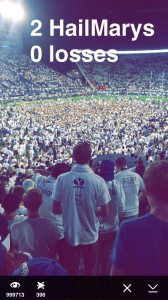
Students who attended the BYU vs. Boise game tweeted, snapchatted and posted all the way up to the game-winning play in the last minute. And all this may have been possible in part because of recent improvements in cellular connectivity in LaVell Edwards Stadium.
In spring 2015, BYU’s athletic department distributed an online survey to more than 60,700 fans who had purchased tickets in the past five years. The survey’s goal was to identify ways to improve the game-day experience in the LaVell Edwards Stadium. Approximately 14,500 people responded to the online survey, said Duff Tittle, Associate Athletic Director–Communications.
“We knew connectivity in the stadium was a major issue, but were surprised to learn through the survey that four of the top six recommendations had to do with cellular or Wi-Fi in LaVell Edwards Stadium,” Tittle said in an email.
Decreased attendance
Attendance at football games is decreasing across the nation. The Wall Street Journal reported in 2014 that average student attendance at college football games had decreased 7.1 percent since 2009.
In 2012, BYU’s average home attendance of 61,161 ranked No. 3 in the West, and BYU consistently has one of the top attendance averages. However, BYU is not an exception to the growing trend of decreased attendance. Attendance at home football games decreased from 64,497 in 2007 to 57,141 in 2014.
Improving cellular connectivity and implementing Wi-Fi into stadiums has been a popular way to combat lower attendance, and BYU is jumping on the bandwagon.
BYU’s plan for cellular connectivity
After the results from the online survey were analyzed, BYU began to make updates and changes.
“This summer BYU worked closely with the four major carriers in Utah–Sprint, Verizon, AT&T and T-Mobile–to identify cellular reinforcement solutions for LaVell Edwards Stadium,” Tittle said. “These solutions should improve basic cell phone functions such as texting and sending and receiving phone calls.”
Sprint and Verizon had installed and tested their cellular reinforcement systems before the home season-opener versus Boise State, and students were pleased with the results.
“My service the other day worked the whole game and my friend’s, who has AT&T, didn’t work at all,” said Alex DuVal, a UVU student who attended the BYU vs Boise game and uses Verizon. “I heard ‘How is your phone working?’ about 1000 times.”
AT&T and T-Mobile are currently in the installation phase, but should be ready by the home game versus Connecticut on Oct. 2.
Wi-Fi in LaVell Edwards Stadium
“Initial estimates for a comprehensive Wi-Fi solution for LaVell Edwards Stadium could cost upwards of $2 million, a significant investment for a venue that is used seven to eight times a year,” Tittle said. “We are working with several companies and reviewing various options, but there will not be a Wi-Fi system in place for this season. We are trying to be creative and find a solution for the 2016 season.”
Changes in cellular connections have been successful so far, and students can look forward to advances with Wi-Fi in the future as well. “There will be growing pains, but the athletic department is committed to improving fan connectivity at the stadium and this is the first step in that process,” Tittle said.




